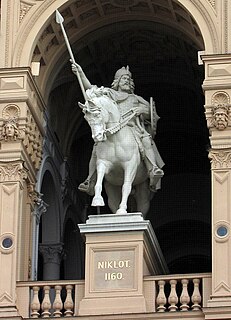The Northern Crusades or Baltic Crusades were Christian colonization and Christianization campaigns undertaken by Catholic Christian military orders and kingdoms, primarily against the pagan Baltic, Finnic and West Slavic peoples around the southern and eastern shores of the Baltic Sea, and to a lesser extent also against Orthodox Christian Slavs.
Saint Gottschalk was a prince of the Obotrite confederacy from 1043 to 1066. He established a Slavic kingdom on the Elbe in the mid-11th century. His object in life seems to have been to collect the scattered tribes of the Slavs into one kingdom, and to make that kingdom Christian.

Polabian Slavs is a collective term applied to a number of Lechitic tribes who lived along the Elbe river in what is today eastern Germany. The approximate territory stretched from the Baltic Sea in the north, the Saale and the Limes Saxoniae in the west, the Ore Mountains and the Western Sudetes in the south, and Poland in the east. They have also been known as Elbe Slavs or Wends. Their name derives from the Slavic po, meaning "by/next to/along", and the Slavic name for the Elbe.
According to a Wendish legend, Plusso or Blusso killed Johannes Scotus, Bishop of Mecklenburg in sacrifice to Radegast during a pagan rebellion against Christianity in the Holy Roman Empire on November 10, 1066. Plusso delivered the bishop's head on a stake in the Radegast temple at Rethra and danced with his wife Guidda, in celebration of the deed.
Wolkwitz is a family name, or surname, of German/Yiddish/Western-Slavic origins.
Berno, Bishop of Schwerin, also known as the Apostle of the Obotrites or Berno of Amelungsborn was a pre-eminent missionary to the Obotrites in the territory of Mecklenburg, Germany, and the first Bishop of Schwerin.
Kruto, son of Grin or Grinus, was a prince of Wagria. James Westfall Thompson believed his family belonged to the Rani of Rugia.
Henry was an Obotrite prince or king (1093–1127) from the Nakonid dynasty; he was regarded by contemporaries as "King of the Slavs". The Obotrite realm reached its greatest area during Henry's rule, extending from the Elbe to the Oder and from the Havelland to the Baltic Sea.
Budivoj, Buthue, or Butue was the eldest son of Gottschalk, an Obotrite prince, by a mistress. He allied with the dukes of Saxony in order to recover the power and position of his father, lost since Gottschalk's death (1066) to the pagan Kruto.

Niklot or Nyklot was a chief or prince of the Slavic Obotrites and an ancestor of the House of Mecklenburg. He became chief of the Obotrite confederacy, including the Kissini and the Circipani, between the years 1130 and 1131. He remained in this position until his death in 1160. At the same time he was Lord of Schwerin, Quetzin and Malchow. For nearly 30 years he resisted Saxon princes, especially Henry the Lion during the Wendish Crusade.
The Nakonids were the leading noble family of the Slavic peoples of the Elbe River from ca. 960 until 1129. They were themselves of Obotrite origin and engineered the formation of a Slavic principality in the region. They became extinct in the male line in the early 12th century. Their capital was Mecklenburg Castle.
Ratibor was a prince of the Obotrite confederacy from the Polabian tribe. His capital was Racisburg, which was named in his honor.
The Battle of Schmilau was a battle between a coalition of Christian forces and pagan Slavic Obotrites in 1093.
Pribislav was an Obotrite prince who ruled Wagria as "Lesser king" (regulus) and resided in Liubice, governing one half of the Obotrite lands, the other half being governed by Niklot.
Pribislav was an Obotrite prince and the first Prince of Mecklenburg (1167–1178).

Liubice, also known by the German name Alt-Lübeck, was a medieval West Slavic settlement near the site of modern Lübeck, Germany. Liubice was located at the confluence of the Schwartau with the Trave across from Teerhof Island, approximately four kilometres north of Lübeck's island old town. The residence of Henry, the Christian prince of the Obotrites, Liubice was destroyed after his death by the pagan Rani of Rugia.

Mecklenburg Castle was a medieval castle and a residential capital of the Nakonid and Nikloting dynasties of the Obotrites. It was located just south of the modern village Dorf Mecklenburg, seven kilometres south of the Bay of Wismar in Mecklenburg-Vorpommern, Germany. The only remnants of the ruined castle are parts of an earthen wall. Some scholars have associated Mecklenburg with the medieval trading emporium Reric.
Bucu or Buku is a hill island surrounded by the Trave and Wakenitz Rivers in Lübeck, Germany. It is also the name of a medieval Slavic castle, now ruined, on the island. Count Adolf II of Holstein founded Lübeck on the island in 1143. The Burgkloster, or fortified monastery, of Lübeck is located atop the ruins of Bucu. "Bucu" is also the name of a hill.

The Prince-Bishopric of Lübeck, was an ecclesiastical principality of the Holy Roman Empire until 1803. Originally ruled by Roman-Catholic bishops, after 1586 it was ruled by lay administrators and bishops who were members of the Protestant Holstein-Gottorp line of the House of Oldenburg. The prince-bishops had seat and vote on the Ecclesiastical Bench of the College of Ruling Princes of the Imperial Diet.

The Lutici or Liutizi were a federation of West Slavic Polabian tribes, who between the 10th and 12th centuries lived in what is now northeastern Germany. Four tribes made up the core of the federation: the Redarians, Circipanians (Circipani), Kessinians and Tollensians (Tholenzi). At least in part, the Lutici were a continuation of the Veleti. In contrast to the former and the neighboring peoples, the Lutici were not led by a Christian monarch or duke, rather power was asserted through consensus formed in central assemblies of the social elites, and the Lutici worshipped nature and several deities. The political and religious center was Radgosc.





